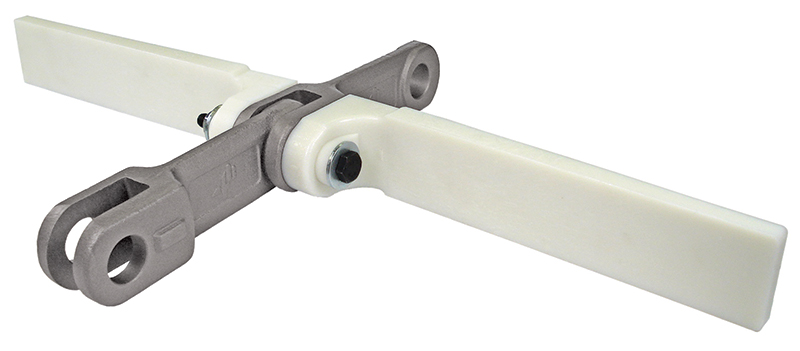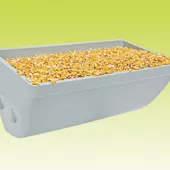4B Braime Outline the Cost of En-mass Chain Conveyors

First published in the August 2014 issue of Quarry Management as Making the Link
4B Braime outline the true cost of en-masse chain conveyors and explain how their Bolt ‘n’ Go chain and flight system can help reduce running costs
Chain conveyors are an essential part of many bulk-handling systems used to convey materials such as powders, grains, flakes and pellets. Many of these conveyors use drop forged chains with flights as the means of conveying the material in question. These ‘en-masse’ conveying systems are very popular as they provide a simple but highly efficient way of moving materials.
When purchasing a chain conveyor, it is easy to look no further than the one-time purchasing cost and the quality of the components. But the problem with conveyors is that they are exposed to a lot of wear and tear, and even the best chains can fail after a period of time, although some can last many years depending on their usage and maintenance.
A big part of the lifetime cost of an en-masse chain conveyor is maintenance: the cost of replacement chains and links; the cost of the labour; and the cost of downtime.
So how does an en-masse conveying system work and where does the chain failure occur? With en-masse conveying, the flight height can be as little as 12.5% of the material being transported by the chain conveyor. The material is fed into the conveyor from above and falls through the moving chain to the bottom of the box. Because the particles interlock, the material moves as a single stream at the same speed as the chain. This highly efficient process allows nearly the entire conveyor cross-section to move in bulk.
Traditionally, chain conveyor flights are made of steel and welded on to the links. The links with flights can be assembled in many different arrangements using pins and circlips, headed pins and circlips or headed pins with collars and roll pins. The whole assembly is very robust and works well until general wear, operational errors, material build-up etc result in maintenance shutdown.
In the case of a minor incident, such as the flights breaking, although the chain does not need to be changed, it is still necessary to order new chain links with welded flights or to grind the sides of the failing links and weld new flights in place on site. In both cases, a lot of time and resources are needed to complete the maintenance procedure. Having new links with welded flights is only the first step of the process: the chain needs to be slackened; the circlips must be broken in order to take out the links where the flights have failed; the new links with welded flights need to be put in; and, finally, the chain has to be tensioned again before the conveyor can return to operation. In some cases the whole chain may need to be removed from the conveyor.
Another major cause for concern with this traditional assembly method is the fact that the circlips can sometimes come loose due to poor installation, not only causing the chain to collapse and, therefore, stopping the conveyor, but also contaminating the material being conveyed and risking obstructions in the downstream process plant.
Over the years, engineers have worked hard to suppress and minimize the various different problems encountered with chain conveyors, including solutions such as more frequent maintenance checks, metal detectors etc. Whilst this has helped to reduce the number of unexpected breakdowns, it has not removed the need for conveyor shutdowns when the chains or flights finally need to be replaced. However, engineers at 4B Braime have come up with a simple solution that can minimize conveyor maintenance downtime and overcome a lot of the problems that might be encountered.
4B’s Bolt ‘n’ Go system is a new flight system that eliminates the need for welded flights and pin and circlip assemblies, which are relatively costly and time-consuming to manufacture. The new system includes:
- A set of nylon flights that can be cut to accurate lengths depending on the desired overall width. These nylon flights are very strong and wear resistant but light in weight, thereby reducing the amount of power required to drive the chain.
- A hollow pin made of alloy steel (the same material as the link) and case hardened to C57–C62 will take the load in the assembly. This pin is very strong and can be supplied in stainless steel for applications in corrosive environments.
- Bolts, nuts and washers are used to hold the flights on to the link and to assemble the links together. Lock nuts are used to secure the whole system.
- At no point does the bolt take the load nor is it in contact with the pin; it merely holds and secures the flights.
- The system uses 4B drop forged chain links that have special lugs on their sides, on to which the flights are fastened, giving the assembly extra stability.
4B say the Bolt ‘n’ Go system, which is easy to install yet very robust with a long lifespan, has many advantages in comparison with the traditional pin and circlip assembly. In particular, the system saves time and money when conducting maintenance, as there is no need to take the tension out of the chain and/or the chain out of the conveyor before changing the flights; the old flights can be taken out and new ones fitted while the chain is still tensioned inside the conveyor. The Bolt ‘n’ Go system also allows full use of the links as it is not necessary to change them every time new flights are needed. Again, this can represent a significant saving for facilities using this system.
Furthermore, 4B’s Bolt ‘n’ Go chain links are made of special heat-treated alloy steel, case hardened to Rockwell C57–C62 with a ductile core hardness of Rockwell C40. This provides the optimum chain link with a resilient ductile core for shock resistance and an extremely hard exterior surface for superior wear and corrosion resistance, resulting in reduced downtime and maintenance, and an increase in the working life of the chain conveyor. The system has been such a success that many suppliers of en-masse chain conveyors now offer Bolt ‘n’ Go as an option. The chain and flight system is currently available for 4B102NA, 4B142NA and 4B142HA links with flights up to 750mm wide.
For more information visit: www.go4b.com
- Subscribe to Quarry Management, the monthly journal for the mineral products industry, to read articles before they appear on Agg-Net




